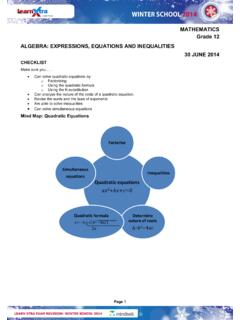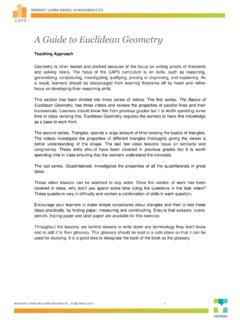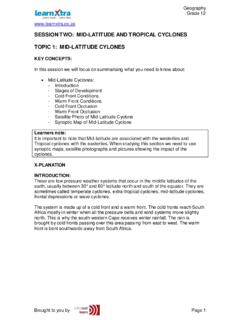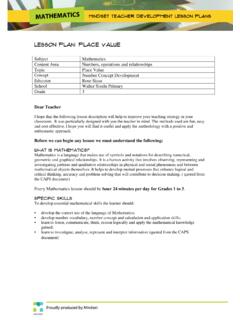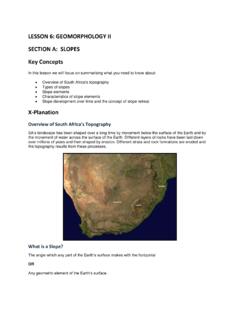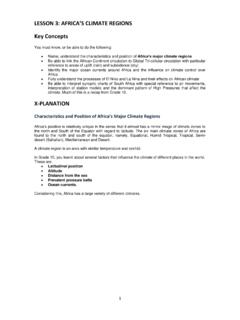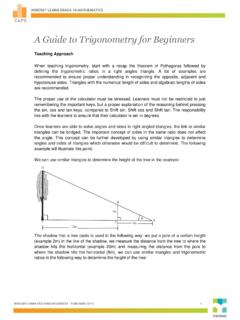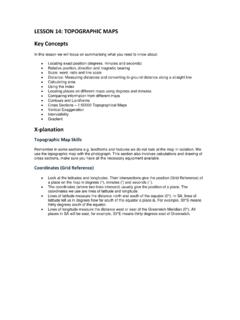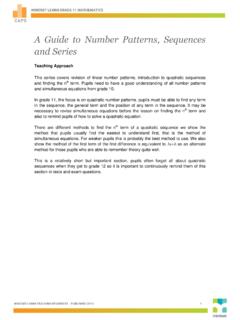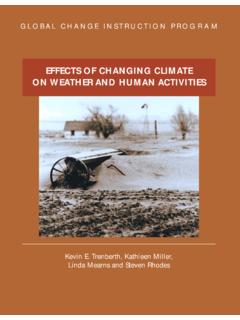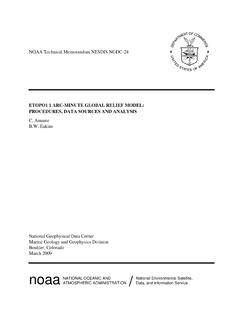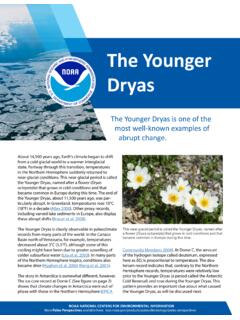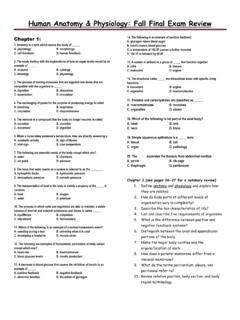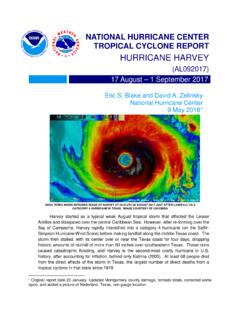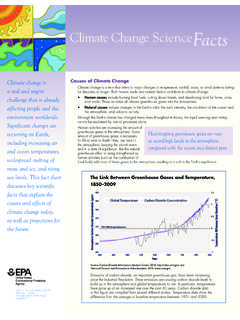Transcription of Global Air Circulation - Mindset Learn
1 1 LESSON 2: Global AIR Circulation Key Concepts In this lesson we will focus on summarising what you need to know about: The mechanics present to create Global wind and pressure belts as a response to the unequal heating of the atmosphere The relationships between air temperature, air pressure and wind The direction of movement and the speed of winds are related to pressure gradient, Pressure gradient force, Coriolis force and Geostrophic flow The link between a stationary earth atmospheric Circulation pattern and one that occurs as a result of the spinning of the earth on its axis The position and name the major pressure belts of the Earth The ideas of pressure gradient force and Coriolis force in creating a tri-cellular Circulation of the Hadley, Ferrel and Polar cells and the surface winds that arise The name and description of the characteristics of large air masses present in the atmosphere The origin and effect of winds related to regional (Monsoon) and local air movements (F hn)
2 Using and interpreting statistics, graphs, maps and use of an atlas in your explanations X-PLANATION Global Wind and Pressure Belts as a Response to the Unequal Heating of the Atmosphere As you will remember from lesson 1, Equatorial Regions receive more direct solar radiation than do polar areas. Water maintains its heat, while, land heats and cools in a 1 day cycle. Since water loses heat slowly, more heat is received than lost through radiation in the Equatorial Regions. In the Polar Regions, just the opposite is true. More heat is lost due to radiation than is received. Since the Tropics do not become progressively hotter and Polar Regions colder, there must be a transfer of heat between the two regions or a general Circulation . The mechanism that sets up Earth s general Circulation pattern is the latitudinal transfer of heat. We will deal with the Global Circulation patterns later in this lesson. We need to look at some basics of pressure and winds which will assist with the understanding of Global wind and pressure belts.
3 Relationships between air temperature, air pressure and wind The accompanying diagram (Figure 1) will show how variations in temperature cause updrafts, downdrafts, surface winds and upper air winds. It is important to know that some additional factors are critical in understanding the Circulation of air in our atmosphere. They will be covered in this chapter as well. 2 Figure 1 Circulation as a result of uneven heating of the Earth s surface Warm air is lighter than cold air. Air that rises on its own (or wants to rise) is known as unstable air. Unstable air is associated with the possibility of cloud formation. Cold air is normally regarded as stable and is an indicator of cloud free conditions. The EXCEPTION is where stable air is forced to rise in the case of a mountain or surface convergence amongst others. Direction of Movement and the Speed of Winds are Related to Pressure Gradient, Friction, Pressure Gradient Force, Coriolis Force and Geostrophic Flow Pressure Gradient and Friction Pressure gradient affects the wind SPEED Figure 2 Sea level synoptic chart for Australia Pressure gradient is a HORIZONTAL CHANGE IN PRESSURE between areas of high and low pressures.
4 Horizontal changes in pressure arise mainly as a result of uneven heating of the earth s surface. Remember (from Grade 10) that an isobar is a line joining places of equal atmospheric pressure Refer to figure 2 that shows two distinct spacing of isobars labelled A and B CLOSELY SPACED ISOBARS INDICATE A STRONG WIND. (A) ISOBARS SPACED FURTHER APART INDICATE A WEAK WIND. (B) 3 Friction affects the wind SPEED Figure 3 Effects of friction on wind speeds If we compare pressure gradients over the land, ocean and the upper atmosphere as being equal, the speeds of wind would be different. The land surface is rough and uneven. Wind speeds are the slowest here. The ocean surface has considerably less friction and wind speeds over the ocean are much higher with the same pressure gradient. As one measures wind speeds in the upper atmosphere, this is regarded as an almost friction free zone. With the same pressure gradient (as for land and ocean) the winds speeds are the greatest and very strong.
5 Pressure Gradient Force (PGF) and Coriolis Force influence the DIRECTION of Wind Wind direction is influenced by TWO forces: 1. Pressure gradient force 2. Coriolis force Pressure Gradient Force (PGF) Pressure gradient force (PGF) acts directly from a high pressure to a low pressure at 90 to the isobars. It is this force that initiates (starts) the horizontal movement of air (wind) 4 Figure 4 Direction of PGF Coriolis Force (CF) Coriolis force only affects the horizontal movement of air (wind) ONCE IT HAS STARTED TO MOVE. (NB. PGF is the primary cause of air starting to move). Coriolis force is set up by the rotation of the earth and will only react once an air movements start, Coriolis force DEFLECTS (bends) winds away from the direction from PGF to the left in the Southern Hemisphere and to the right in the Northern Hemisphere. Figure 5 Effect of PGF and CF on winds Ferrel s Law Standing with your back to the wind, air is deflected to the left in the Southern Hemisphere and to the right in the Northern Hemisphere.
6 5 Geostrophic flow Upper atmosphere wind in a friction free zone Geostrophic winds These are resultant winds flowing parallel to the isobars found in the upper atmosphere. Figure 6 Geostrophic flow in the Southern Hemisphere over South Africa. Pressure gradient force ( ) acts from High to Low Pressure acts at right angles to the isobars. Coriolis force (CF.) is a deflective force due to the rotation of the earth. will cause winds to be deflected to the right in the Northern Hemisphere and to the left in the Southern Hemisphere. Once an air parcel starts moving, it moves from high to low pressure. Once it moves, acts at right angles to the wind. When the and the are acting in opposite directions, the wind Is no longer deflected. This wind is now blowing parallel to the isobars. It is known as the Geostrophic Wind. Near the surface of the earth, friction causes winds to cross the isobars at an angle.
7 In the upper air, friction is less arid therefore a Geostrophic Wind is found. 6 Global Circulation Pattern of Pressure Belts and Winds Global Pattern of Pressure Belts Figure 7 World pressure belts Pressure Gradient Force and Coriolis Force in Creating a Tri-Cellular Circulation of the Hadley, Ferrel and Polar Cells and the Surface Winds that arise Circulation of air in the atmosphere (if the earth were not rotating). In general Circulation theory, areas of low pressure exist over the Equatorial Regions, and areas of high pressure exist over the Polar Regions due to differences in temperature. Insolation received by the Earth, and converted to heat, causes air to become less dense and rise in equatorial areas. The resulting low pressure allows the high-pressure subsidence air at the poles to move along the planet s surface toward the Equator. As the warm air flows toward the poles in the upper atmosphere, it cools, becoming denser, and sinks over the Polar Regions.
8 This is the simplistic explanation if the Earth were stationary and not spinning on its axis. An imaginary uniform Earth with idealized zonal (continuous east to west) pressure belts. The real Earth has disruptions in its zonal pattern caused by large land masses. These disruptions break up pressure zones into semi-permanent high and low pressure cells. The most permanent belts are found over the oceans 7 Figure 8 Circulation pattern if the Earth was not spinning on its axis Tri-cellular Circulation of the Hadley, Ferrel and Polar Cells and the surface winds that arise as a result of the spinning of the Earth on its axis As has been discussed so far, the force created by the rotation of the Earth is known as Coriolis force. It significantly affects air that moves over great distances. The Coriolis force deflects air to the right in the Northern Hemisphere and to the left in the Southern Hemisphere, causing it to follow a curved path instead of a straight line.
9 The amount of deflection increases with increasing latitude. The amount of deflection also increases with increasing speed. The faster the wind speed the greater the deflection. This changes the general Circulation pattern of the air. The speed of the Earth s rotation causes the general flow (Figure 8) to break up into three distinct cells in each hemisphere. (Figure 9) Figure 9 The three convectional cells produced per hemisphere as a result of the Earth spinning on its axis 8 Characteristics of the three Circulation cells mirrored in the Northern Hemisphere and Southern Hemisphere. Along the equator, moist surface winds converge. Updrafts of moist air cause the development of cloud formation and it rains a lot Between 20 and 35 degrees latitude, descending dry and warm air masses give rise to cloudless skies and desert climates. Along the polar front, updrafts air masses again give rise to cloud formation and rain.
10 The three atmospheric cells in each hemisphere are named Hadley 0 - 30 N/S Ferrel 30 - 60 N/S Polar 60 - 90 N/S Figure 10 Tri-cellular Circulation with winds Hadley Cell George Hadley identified the equatorial cells named after him in 1735 based on wind direction records from British ships. It was remarkable intuition on his part to extrapolate surface winds into a three dimensional model (Figure 11). Figure 11 Hadley cell 9 The tropical winds that blow from the south east and north east (Trade winds) to the equatorial area, meet in the inter-tropical convergence zones (ITCZ). (Figure 12) Much of the air that rises at the equator does not move directly to the poles. As a result of Coriolis force from the spinning of the Earth, down drafts descends on the 30 latitude to the surface of the earth. Some of this air returns to the equator in the form of surface winds.
